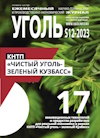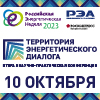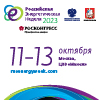
ECOLOGY
Original Paper
UDC 621.182.001.33 (072):662.6© P.V. Roslyakov, D.O. Skobelev, M.V. Dobrokhotova, T.V. Guseva, 2023
ISSN 0041-5790 (Print) • ISSN 2412-8333 (Online) • Ugol’ – Russian Coal Journal, 2023, ¹ 9, pp. 84-89
DOI: http://dx.doi.org/10.18796/0041-5790-2023-9-84-89
Title
ASSESSING GREENHOUSE GAS EMISSIONS FOR COAL-FIRED POWER PLANTS IN THE CONTEXT OF CARBON REGULATION DEVELOPMENT IN THE RUSSIAN FEDERATION
Authors
Roslyakov P.V.1, Skobelev D.O.2, Dobrokhotova M.V.2, Guseva T.V.2
1National Research University “Moscow Power Engineering Institute” (MPEI), Moscow, 111250, Russian Federation
2Federal State Autonomous Institution “Research Institute “Environmental Industrial Policy Center” (EIPC), 141006, Mytishchi, Russian Federation
Authors Information
Roslyakov P.V.,Doctor of Engineering Sciences, Professor, Professor of the Department for Modelling and Project Design of Energy Generation Units, e-mail: RoslyakovPV@mpei.ru
Skobelev D.O., Doctor of Economic Sciences, Director, e-mail: training@eipc.center
Dobrokhotova M.V., Deputy Director, e-mail: M.Dobrokhotova@eipc.center
Guseva T.V., Doctor of Engineering Sciences, Professor, Deputy Director (Research), e-mail: Tatiana.V.Guseva@gmail.com
Abstract
Heat and power industry is one of the key contributors to anthropogenic greenhouse gas emissions. Total emissions from fuel combustion for energy generation in the Russian Federation amounted to 819 million tons of CO2-eq in 2020. Emission reducing solutions applied by the heat and power sector include the transition from coal to natural gas as main fuel for combustion, the introduction of combined cycle plants, increasing the efficiency factor for electricity generated at condensing power plants (CPPs) by installing new equipment with increased steam parameters. It is emphasized that to reduce indirect greenhouse gas emissions in the real sector of economy, first – in metallurgy and chemical industry, it is important to decrease direct emissions in electric and thermal energy generation sector. It is pointed out that carbon regulation development requires the identification of priority areas for limiting emissions and setting sectoral indicative parameters. It should be noted that Russian approach to the substantiation of indicative parameters has the form of the industry benchmarking procedure performed during the process of updating Reference Documents (BREF) on Best Available Techniques (BAT). The paper determines mass and specific CO2 emissions for coal-fired thermal power plants (TPPs). Obtained data can be used for reviewing BREF 38-2022 “Fossil Fuel Combustion for Production of Energy by Large Plants”, as well as for thermal power plant carbon reporting. The authors identified thermal coal types with the highest CO2 emissions and assessed the potential for reducing greenhouse gas emissions after introduction of combined-cycle plants and steam turbine plants for supercritical steam parameters.
Keywords
Energy generation, Coal-fired thermal power plants, carbon regulation, greenhouse gases, carbon dioxide, mass and specific air emissions, indicative air emission parameters.
References
1. Federal Law No 296-FZ of 02.07.2021 “On Limiting Greenhouse Gas Emissions”. [Electronic resource]. Available at: http://www.consultant.ru/document/cons_doc_LAW_388992/ (accessed 15.08.2023). (In Russ.).
2. Executive Order of the Government of the Russian Federation No 3052-r of 29.10.2021 “On Approval of the Strategy of Socio-Economic Development of the Russian Federation with Low Greenhouse Gas Emissions until 2050”. [Electronic resource]. Available at: www.consultant.ru/document/cons_doc_LAW_399657/ (accessed 15.08.2023). (In Russ.).
3. The National Report of the Russian Federation on the Inventory of the Anthropogenic Emissions and Sinks of Greenhouse Gases Not Controlled by the Montreal Protocol. [Electronic resource]. Available at: http://www.igce.ru/performance/publishing/reports/ (accessed 15.08.2023). (In Russ.).
4. Petrov I. V., Utkin I.I. & Jayant V.B. Proposals for Decarbonization of the Coal Industry and Sustainable Development of Isolated Regions Based on Underground Coal Gasification. Ugol’, 2022, (9), pp. 41–47. (In Russ.). DOI: 10.18796/0041-5790-2022-9-41-47.
5. Fedash A.V., Vartanov A.Z. & Petrov I.V. Problems of Innovative Development of the Fuel and Energy Industry in Russia. IOP Conference Series: Earth and Environmental Science, 2018, (206), 012015. DOI: 10.1088/1755-1315/206/1/012015.
6. Yinhai Fang & Haiyan Xu. Research on Decarbonization Pathway of China’s Coal-Fired Power Industry from the Perspective of Conflict Mediation. Frontiers of Environmental Science, 2022, (10). DOI: 10.3389/fenvs.2022.930322.
7. Aliabadi D.E. Decarbonizing Existing Coal-Fired Power Stations Considering Endogenous Technology Learning: A Turkish Case Study. Journal of Cleaner Production, 2020, (261). DOI: 10.1016/j.jclepro.2020.121100.
8. Executive Order of the Government of the Russian Federation No 2674-r of 24.12.2014 “On Approval of the List of Areas of Application of the Best Available Techniques”. [Electronic resource]. Available at: https://docs.cntd.ru/document/420242884#6540IN (accessed 15.08.2023). (In Russ.).
9. Roslyakov P.V., Kondrat’eva O.E. & Borovkova A.M. Regulatory and Methodical Support of the Transition to the BATs in Heat Power Engineering.Thermal Engineering, 2018, (65), pp. 317–323. (In Russ.) DOI: 10.1134/S0040601518050105.
10. BREF 38-2022 “Fuel Combustion at Large Installations for Energy Production”. (In Russ.)
11. Dobrokhotova M.V. Specific Features of the Russian Coal Industry’s Transition to the Best Available Techniques. Ugol’, 2022, (9), pp. 34-40. (In Russ.). DOI: 10.18796/0041-5790-2022-9-34-40.
12. Bashmakov I.A., Skobelev D.O., Borisov K.B. & Guseva T.V. Benchmarking Systems for Greenhouse Gases Specific Emissions in Steel Industry. Ferrous Metallurgy. Bulletin of Scientific, Technical and Economic Information, 2021, Vol. 77, (9), pp. 1071–1086. (In Russ.). DOI: 10.32339/0135-5910-2021-9-1071-1086.
13. Bolay A.-F., Bj?rn A., Weber O. & Margni M. Prospective Sectoral GHG Benchmarks Based on Corporate Climate Mitigation Targets. Journal of Cleaner Production, 2022, (376). DOI: 10.1016/j.jclepro.2022.134220.
14. Lopin Kuo, Bao-Guang Chang. Ambitious Corporate Climate Action: Impacts of Science-Based Target and Internal Carbon Pricing on Carbon Management Reputation – Evidence from Japan. Sustainable Production and Consumption, 2021, (27), pp. 1830–1840. DOI: 10.1016/j.spc.2021.04.025.
15. Huachun He, Hongjun Guan, Xiang Zhu & Haiyu Lee. Assessment on the Energy Flow and Carbon Emissions of Integrated Steelmaking Plants. Energy Reports, 2017, (3), pp. 29–36. DOI: 10.1016/j.egyr.2017.01.001.
16. Forecast of Scientific and Technological Development of Branches of the Fuel and Energy Complex of Russia for the Period up to 2035. Ìoscow, Ministry of Energy of Russian Federation, 2016. [Electronic resource]. Available at: https://docs.cntd.ru/document/456026524?ysclid=ler5yixiho947857367 (accessed 15.08.2023). (In Russ.).
17. Gao Li, Li Ruonan, Mei Yingdan & Zhao Xiaoli. Improve Technical Efficiency of China’s Coal-Fired Power Enterprises: Taking a Coal-Fired-Withdrawal Context. Energy, 2022, (252), 123979. DOI: 10.1016/j.energy.2022.123979.
18. Global Change Data Lab. [Electronic resource]. Available at: https://ourworldindata.org/organization (accessed 15.08.2023).
19. Suer J., Ahrenhold F. & Traverso M. Carbon Footprint and Energy Transformation Analysis of Steel Produced via a Direct Reduction Plant with an Integrated Electric Melting Unit. Journal of Sustainable Metallurgy, 2022, (8), pp. 1532–1545. DOI: 10.1007/s40831-022-00585-x.
20. Report on the Implementation in 2021 of the Activities of the Russian Coal Industry Development Program for the Period up to 2035 No ÑÌ-7541/12 of 01.06.2022. [Electronic resource]. Available at: https://minenergo.gov.ru/node/433 (accessed 15.08.2023). (In Russ.).
21. Information and Analytical Report “On the State of Heat Power and District Heating in Russian Federation in 2020”. Ìoscow, Russian energy agency Publ., 2021. (In Russ.).
22. Kuznetsov N.V., Dubovskiy I.E. & Mitor V.V. Thermal calculation of boiler units. The normative method. Minsk, Ecolit Publ., 2020. (In Russ.).
23. Roddatis K.F. & Poltaretskiy A.N. Handbook of low-capacity boiler plants. Moscow, Energoatomizdat Publ., 1989. (In Russ.).
For citation
Roslyakov P.V., Skobelev D.O., Dobrokhotova M.V. & Guseva T.V. Assessing greenhouse gas emissions for coal-fired power plants in the context of carbon regulation development in the Russian Federation.Ugol’, 2023, (9), pp. 84-89. (In Russ.). DOI: 10.18796/0041-5790-2023-9-84-89.
Paper info
Received August 4, 2023
Reviewed August 14, 2023
Accepted August 25, 2023









